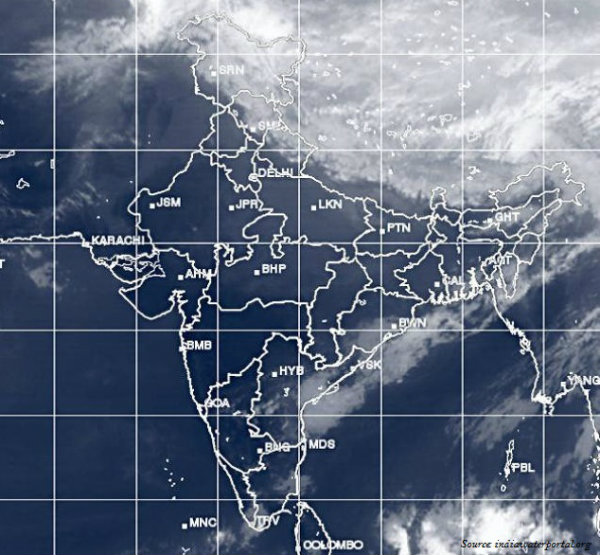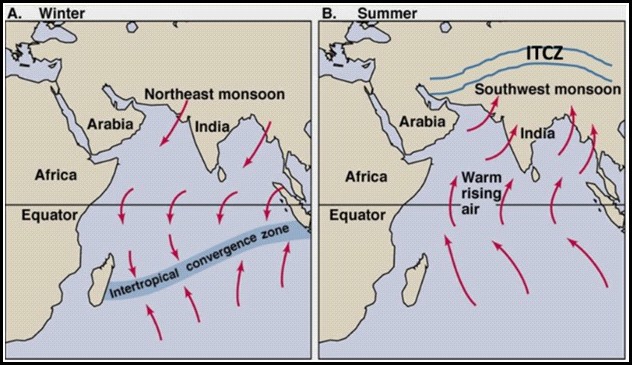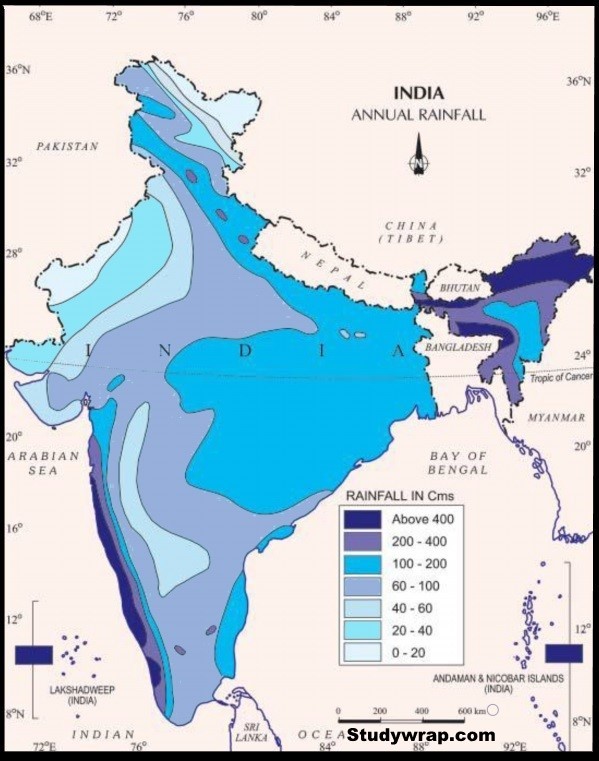Geography
Factors Influencing Indian Climate – Indian Climate
Indian Climate – Factors Influencing Indian Climate
Table of Contents
“We may speak of climates but not the climate of India, for the world itself affords, no greater contrast than is to be met with at one and the same time within its limits.”
– Blanford
- Climate of a country includes the study of temperature, rainfall, atmospheric pressure, Direction and velocity of wind etc. over a long period of time.
- Factors Influencing Indian Climate includes latitudes, relief distribution of land and water etc.
- As said by L.D. Stamp – India is basically a tropical country although its northern part is situated in the temperate region.
- This can be proved by the facts –
-
- In north, the Himalaya separates the Indian subcontinent from rest of Asia. Thus, preventing the cold air masses to enter India.
- Hence the norther part of India remains 3o C to 8o C warmer than other places on same Latitude during winters.
- During summer, due to overheating and overhead position of the sun the climate in southern part of India resembles the equatorial climate.
- The northern Indian plains are influenced by hot dry winds called ‘Loo’ which blows from Thar, Baloch, and Iranian desert which increases the temperature of north India comparable to southern India.
- Thus the whole of India south of Himalaya can be treated as Tropical County.
-
- The seasonal reversal of the winds in Arabian Sea and Bay of Bengal gives India Tropical Monsoon Climate.
- So, Indian Climate is Tropical Monsoon type rather than tropical or temperate type climate.
Factors Influencing Indian Climate
- Factors influencing the Indian Climate includes –
- Latitudinal location
- Distance from the Sea
- The Northern Mountain Ranges
- Physiography
- Monsoon Winds
- Upper Air Circulation
- El Nino and La Nina
- Tropical Cyclones and Western Disturbances
1. Latitudinal location
-
- The mainland of India extends roughly between 8°N to 37°N and Tropic of Cancer divides India into Two half’s.
- Areas south of the Tropic of Cancer are in tropics and hence receive high solar insolation. Hence have high summer and moderate winter temperatures.
- Coastal regions see moderate climatic conditions irrespective of latitudinal position due to the Arabian Sea and Bay of Bengal.
- The northern parts on the other hand lie in the warm temperate zone. They receive comparatively less solar insolation. But summer are equally hot in north India because of ‘loo’. Winter are very cold due to cold waves brought by the western disturbances. Some places in Himalayas record low temperatures during winter.
2. Distance from the Sea
-
- Coastal regions have moderate or equable or maritime climate but the interior locations are deprived of the moderating influence of the sea and experience extreme or continental climate.
- The Monsoon winds first reaches the coastal areas which get the highest amount of rainfall as compared to interior places.
3. The Northern Mountain Ranges
-
- The Himalayan Mountain Ranges separates India from rest of Asia.
- During winter, Himalayas protect India from cold and dry air masses of Central Asia.
- During monsoon months these mountain ranges act as an effective physical barrier for rain bearing south-west monsoon winds to cross the northern frontier of India.
- The Bay of Bengal branch of monsoon winds is divided into two branches by the Himalayas
-
-
- one branch flowing along the plain regions towards north-west India and
- The other towards South-East Asia in Purvanchal.
-
-
- The monsoon winds would move into China and most of the north India would have been a desert if the Himalayas were not present as they prevent the monsoon winds.
- The Monsoon winds loses its moisture as they move forward in westward direction thus causing less rainfall as they moves towards Delhi.
4. Physiography
-
- Physiography of India, a major Factors Influencing Indian Climate, has a great bearing on major elements of climate such as temperature, atmospheric pressure, direction of winds and amount of rainfall.
-
- Places on higher altitude have cool climate even if they are in peninsular India. Eg. Ooty.
-
- Physiography is the most important factor that determines the mean annual rainfall received by a region.
- Distribution of rainfall in peninsular India – (Semi-Arid Regions of Peninsular India) The south west monsoon winds from Arabian Sea strikes almost perpendicular to Western Ghats which acts as an Orographic Barrier and cause extreme rainfall in western coastal plains and the western slopes of the Western Ghats. Regions which lies in rain-shadow or Leeward region receives scanty rainfall. Vast areas of Maharashtra, Karnataka, Telangana, Andhra Pradesh and Tamil Nadu lie in rain-shadow region.
- Heavy Rainfall in Cherrapunji and Mawsynram – Monsoon winds from Bay of Bengal are bifurcated into two branches one of which enters the Brahamputra valley through Meghalaya Plateau. Here the Cherrapunji valley forces the monsoon winds to rise along the steep slopes and results in extreme rainfalls. Mawsynram and Cherrapunji are the wettest places on earth with mean annual rainfall over 1000 cm. Hence extreme rainfall in these places is due to funnelling effect followed by orographic upliftment.
- No significant rainfall in Gujarat and Rajasthan – Monsoons winds flowing in Rajasthan and Gujarat are not obstructed by any orographic barrier and hence these regions receive no rainfall. They flow parallel to the Aravalli ranges thus no Orographic hindrance. Moreover, there is no vertical movement of the winds because monsoon winds blow toward the low pressure cell in Tibet Plateau. Thus no or very less rain occurs in Rajasthan and Gujarat.
- Physiography of India, a major Factors Influencing Indian Climate, has a great bearing on major elements of climate such as temperature, atmospheric pressure, direction of winds and amount of rainfall.
5. Monsoon Winds
-
- The most dominating factor of the Indian climate is the ‘monsoon winds’ because of which Indian climate is also known as Tropical Monsoon Type of Climate.
-
- Features of Indian Monsoon –
-
- Sudden onset (sudden burst)
- Gradual progress
- Gradual retreat
- Seasonal reversal of winds
-
- The complete reversal of the monsoon winds brings about a sudden change in the seasons.
- The harsh summer season suddenly giving way to monsoon or rainy season.
- The south-west monsoons from the Arabian Sea and the Bay of Bengal bring rainfall to the entire country.
- The north-eastern winter monsoon which travel from land to sea do not cause much rainfall except along the Caromandel coast (TN coast) after getting moisture from the Bay of Bengal.
- Features of Indian Monsoon –
6. Upper Air Circulation
-
- The changes in the upper air circulation over Indian landmass is brought about by Jet streams which influence the climate of India to great extent.
a. Westerly Jet Stream
-
-
- Westerly jet stream blows at a very high speed during winter over the sub-tropical zone which is bifurcated by the Himalayas.
- Northern branch blows along the northern edge of the Himalaya and the Southern branch blows eastward south of the Himalayan range.
- Southern branch of the jet stream exercises a significant influence on the winter weather conditions in India. This jet stream is responsible for bringing western disturbances from the Mediterranean region in to the Indian sub-continent.
- Winter rain and heat storms in north-western plains and occasional heavy snowfall in hilly regions are caused by these disturbances.
- These are generally followed by cold waves in the whole of northern plains.
-
b. Easterly Jet Stream
-
-
- Reversal in upper air circulation takes place in summer due to the apparent shift of the sun’s vertical rays in the northern hemisphere.
- The westerly jet stream is replaced by the easterly jet stream which originates due to the heating of the Tibet plateau.
- This results in development of easterly cold jet stream blowing over peninsular India.
- This helps in the sudden onset of the south-west monsoons.
-
7. Tropical Cyclones and Western Disturbances
-
- Tropical cyclones originate in the Bay of Bengal and Arabian Sea and the influence large parts of the peninsular India.
- Majority of the cyclones originate in the Bay of Bengal and influence the weather conditions during the south-west monsoon season (low intensity cyclones).
- Some cyclones are born during the retreating monsoon season, i.e., in October and November (high intensity cyclones) and influence the weather conditions along the eastern coast of India.
- The western disturbances originate over the Mediterranean Sea and travel eastward under the influence of westerly jet stream.
- They influence the winter weather conditions over most of Northern-plains and Western Himalayan region.
8. El-Nino, La Nina and ENSO
-
- El-Nino
- It is a narrow warm current which occasionally appears off the coast of Peru in December. It is a temporary replacement of the cold Peru Current which normally flows along the coast.
- Adversely affects monsoon rainfall and cyclogenesis in Bay of Bengal.
- Good for cyclogenesis in Arabian Sea.
- Floods and Droughts are common during El Nino events due to less monsoonal and cyclonic rainfall.
- El-Nino
-
- La Nina
- Sometimes Trade Wind becomes so strong that they cause abnormal accumulation of cold water in the central and eastern Pacific region.
- Good for monsoons and cyclogenesis in Bay of Bengal.
- Suppressed cyclogenesis in Arabian Sea.
- Floods are common.
- La Nina
-
- ENSO
- It is referred to the event when there is oscillation or alternating positions of High and low pressure between Indian and Pacific Ocean.
- Southern Oscillation coinciding with El Nino is called ENSO or El Nino Southern Oscillation.
- Climatic conditions same as El Nino.
- When winter pressure is high over Pacific Ocean, the South west monsoon in India tends to be stronger. But in reverse scenario it is most likely to be weaker.
- ENSO
Indian Climatic Diversity
- India has high Regional Climatic Diversity because of its topographical diversity and various Factors Influencing Indian Climate which includes location, altitude, distance from sea and relief etc.
1. Rainfall
-
- The climate in most of the regions is categorized by distinct wet and dry seasons. Some places like Thar Desert, Ladakh have no wet season.
- Mean annual rainfall varies substantially from region to region. Mawsynram and Cherrapunjiin Meghalaya receives around 1,000 cm of annual rainfall while at Jaisalmer the annual rainfall rarely exceeds 12 cm.
- The Ganga delta and the coastal plains of Odisha see intense rainfall in July and August while the Coromandel Coast goes dry during these months.
- Places like Goa, Hyderabad and Patna receive south-west monsoon rains by the first quarter of June while the rains are awaited till early July at places in Northwest India.
2. Temperature
-
- Diurnal and annual temperature ranges are substantial.
- Highest diurnal temperature ranges occur in the Thar Desert and the highest annual temperature ranges are recorded in the Himalayan regions.
- Both diurnal and mean annual temperature ranges are least in coastal regions.
- In December, the temperature may dip to – 40°C at some places in J&K while in many coastal regions average temperature is 20-25°C.
- Winters are moderately cold in most of the regions while the summers are extremely hot.
- Himalayan regions experience brutal winters while the summers are moderate.
So, this is all about the introductory section on Indian climate – Factors Influencing Indian Climate.
In the next post (Click here), we will study about the winter season in India.





